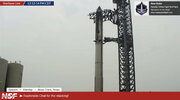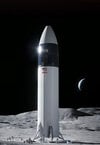but after watching Thursday's incredible concrete chucking launch, wonder if SpaceX and NASA will step up focus on the moon?
SpaceX was awarded the HLS contract and is using that to develop Starship, and clearly NASA is focused on the Moon with the hyper expensive SLS/Artemis program.
Fairly confident that Starships will be able to precisely stick their landings on a flat lunar terrain. Can think of a couple aids to help reduce the risk of damage to the vehicle...Reduced thrust required for one-sixth G. Also, the engines will likely shutdown just prior to actual touchdown. Although seems likely it'll form a crater of undetermined size. Lifting off from the surface would appear to be a bigger concern.
SpaceX released this image sometime last year, I think. What look like bright lights high up on the vehicle are actually thrusters angled downwards. Think Super Dracos. Since lunar gravity is low, it is believed that the vehicle could land with those and avoid using the Raptor vac engines. If so, that will mitigate the issue of displacing lunar regality, as I understand it.
We know there's no traditional Launch Abort System (LAS) for Starship. It likely wouldn't survive a catastrophic failure of Super Heavy early in the ascent.
I think there is a Starship abort system that will work from very early in ascent to stage sep. Command the clamps to release and ignite the Starship raptors. Doesn’t seem like it would work in the first few seconds however.
One of the visualizations of a lunar Starship had thrusters high up on the ship, angled slightly outward. I would think that should avoid cratering. They'd only need to use those thrusters around the surface.
Down the road, I sure hope they'll custom design a ship for landing on the moon. It could have the engines up top and all the stuff that you'd offload down on the bottom, close to the surface. No need for aerodynamics; just engines, fuel tanks, and containers to drop off.
No need to “hope”, in my opinion.

That’s what the NASA HLS contract is for; a Starship specifically designed for landing on the Moon. It will never return to Earth. It will take astronauts from the Lunar Gateway to the lunar surface and back. It won’t have flaps or a heat shield. It will need Raptor Vacs to achieve orbit before departing for the Lunar Gateway, using those same Raptors, after being re-field.
To me it makes much more sense to launch the Lunar Starship to LEO, re-fuel it, launch a Crew Dragon to rendezvous with it, the Lunar Starship takes the astronauts to the lunar surface and then back to LEO, they transfer to Dragon and return to Earth. But that is not the NASA plan because that plan is dictated by Congress, not by sensible space explorers.




